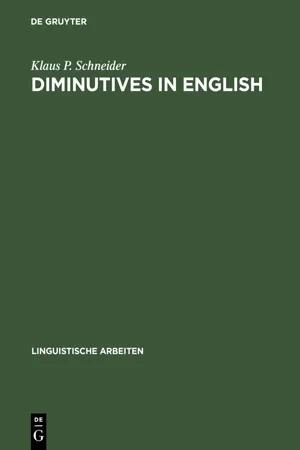
- 266 pages
- English
- PDF
- Available on iOS & Android
Diminutives in English
About This Book
That English has no diminutives is a common myth. The present study shows, however, that English does possess diminutives, and not only analytic but also synthetic diminutive markers. Analytic markers include, first and foremost, little, as well as other adjectives from the same word field, whereas the inventory of synthetic markers comprises suffixes as, for instance, - ie, - ette, - let, - kin, - een, - s, - er, - poo and - pegs. These markers are examined from a grammatical and a pragmatic perspective in an integrative formal-functional framework. The grammatical perspective involves phonological, morphological and semantic features, while the pragmatic perspective involves pragmalinguistic as well as sociopragmatic features on the levels of the speech act and larger interactive units in dialogue. The findings reveal that English diminutive suffixes are, in fact, among the most productive suffixes of the English language. While the suffixes share a number of features, each has developed its own profile, specifically regarding semantic and pragmatic features. In everyday conversation, there is a division of labour between the synthetic and the analytic type of formation concerning the communicative functions of diminutives and their distribution in discourse. The choice of formal device and its function depend crucially on pragmatic factors, notably on the illocution, the interactive status, the realisation strategy, and the politeness value of the utterances in which diminutives are employed, and also on the relationship between the interlocutors.
Frequently asked questions
Information
Table of contents
- Abbreviations
- 0. Aims, claims and structure of the present study
- 1. Introduction
- 1.1. What are diminutives?
- 1.2. Related terms and concepts
- 1.3. Conclusion
- 2. Researching diminutives: the state of the art
- 2.1. Overview
- 2.2. Grammatical approaches to diminutives
- 2.3. Pragmatic approaches to diminutives
- 2.4. Summary and perspectives
- 3. Researching diminutives: integrating grammatical and pragmatic perspectives
- 3.1. The object of analysis
- 3.2. General outline of the research programme
- 3.3. The grammatical perspective: diminutive formation
- 3.4. The pragmatic perspective: diminutive use
- 3.5. Method
- 4. Grammatical aspects of English diminutives
- 4.1. Some controversial issues
- 4.2. Synthetic diminutive formation
- 4.3. Analytic diminutive formation
- 4.4. The relationship between synthetic and analytic diminutive formation in English
- 5. Diminutive use in English conversation
- 5.1. Vocative acts
- 5.2. Directive acts
- 5.3. Commissive acts
- 5.4. Expressive acts
- 5.5. Assertive acts
- 5.6. Summary: diminutive use in English conversation
- 6. Summary and perspectives
- References